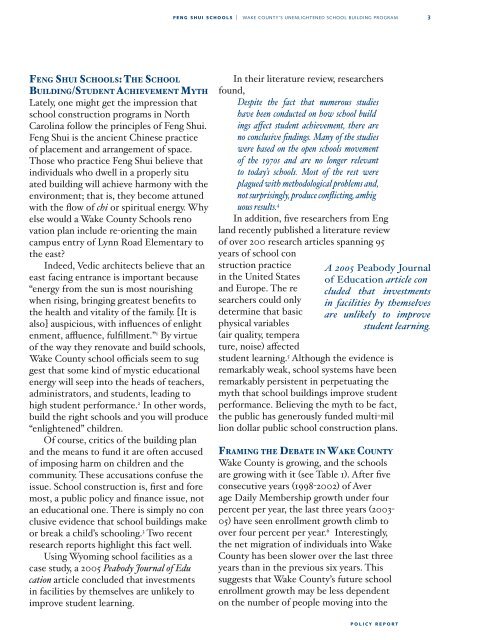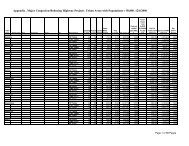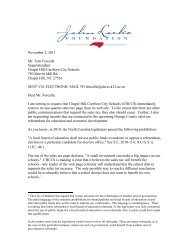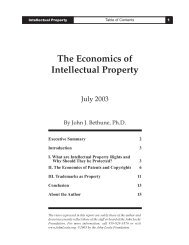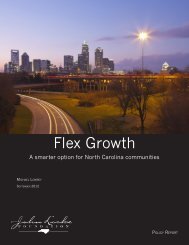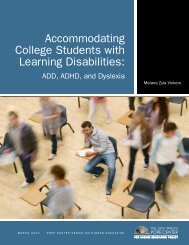Feng Shui Schools - John Locke Foundation
Feng Shui Schools - John Locke Foundation
Feng Shui Schools - John Locke Foundation
Create successful ePaper yourself
Turn your PDF publications into a flip-book with our unique Google optimized e-Paper software.
f e n g s h u i s c h o o l s |<br />
wake County’s unenlightened school building program<br />
<br />
<strong>Feng</strong> <strong>Shui</strong> <strong>Schools</strong>: The School<br />
Building/Student Achievement Myth<br />
Lately, one might get the impression that<br />
school construction programs in North<br />
Carolina follow the principles of <strong>Feng</strong> <strong>Shui</strong>.<br />
<strong>Feng</strong> <strong>Shui</strong> is the ancient Chinese practice<br />
of placement and arrangement of space.<br />
Those who practice <strong>Feng</strong> <strong>Shui</strong> believe that<br />
individuals who dwell in a properly situated<br />
building will achieve harmony with the<br />
environment; that is, they become attuned<br />
with the flow of chi or spiritual energy. Why<br />
else would a Wake County <strong>Schools</strong> renovation<br />
plan include re-orienting the main<br />
campus entry of Lynn Road Elementary to<br />
the east?<br />
Indeed, Vedic architects believe that an<br />
east-facing entrance is important because<br />
“energy from the sun is most nourishing<br />
when rising, bringing greatest benefits to<br />
the health and vitality of the family. [It is<br />
also] auspicious, with influences of enlightenment,<br />
affluence, fulfillment.” 1 By virtue<br />
of the way they renovate and build schools,<br />
Wake County school officials seem to suggest<br />
that some kind of mystic educational<br />
energy will seep into the heads of teachers,<br />
administrators, and students, leading to<br />
high student performance. 2 In other words,<br />
build the right schools and you will produce<br />
“enlightened” children.<br />
Of course, critics of the building plan<br />
and the means to fund it are often accused<br />
of imposing harm on children and the<br />
community. These accusations confuse the<br />
issue. School construction is, first and foremost,<br />
a public policy and finance issue, not<br />
an educational one. There is simply no conclusive<br />
evidence that school buildings make<br />
or break a child’s schooling. 3 Two recent<br />
research reports highlight this fact well.<br />
Using Wyoming school facilities as a<br />
case study, a 2005 Peabody Journal of Education<br />
article concluded that investments<br />
in facilities by themselves are unlikely to<br />
improve student learning.<br />
In their literature review, researchers<br />
found,<br />
Despite the fact that numerous studies<br />
have been conducted on how school buildings<br />
affect student achievement, there are<br />
no conclusive findings. Many of the studies<br />
were based on the open schools movement<br />
of the 1970s and are no longer relevant<br />
to today’s schools. Most of the rest were<br />
plagued with methodological problems and,<br />
not surprisingly, produce conflicting, ambiguous<br />
results. 4<br />
In addition, five researchers from England<br />
recently published a literature review<br />
of over 200 research articles spanning 95<br />
years of school construction<br />
practice<br />
in the United States<br />
and Europe. The researchers<br />
could only<br />
determine that basic<br />
physical variables<br />
(air quality, temperature,<br />
noise) affected<br />
student learning. 5 Although the evidence is<br />
remarkably weak, school systems have been<br />
remarkably persistent in perpetuating the<br />
myth that school buildings improve student<br />
performance. Believing the myth to be fact,<br />
the public has generously funded multi-million<br />
dollar public school construction plans.<br />
A 2005 Peabody Journal<br />
of Education article concluded<br />
that investments<br />
in facilities by themselves<br />
are unlikely to improve<br />
student learning.<br />
Framing the Debate in Wake County<br />
Wake County is growing, and the schools<br />
are growing with it (see Table 1). After five<br />
consecutive years (1998-2002) of Average<br />
Daily Membership growth under four<br />
percent per year, the last three years (2003-<br />
05) have seen enrollment growth climb to<br />
over four percent per year. 6 Interestingly,<br />
the net migration of individuals into Wake<br />
County has been slower over the last three<br />
years than in the previous six years. This<br />
suggests that Wake County’s future school<br />
enrollment growth may be less dependent<br />
on the number of people moving into the<br />
p o l i c y r e p o r t


